Link to Google Scholar citations page
2023
58) Y. Wang, C. Bastiancich, B. Newland*, Injectable Local Drug Delivery Systems for Glioblastoma: A Systematic Review and Meta-Analysis of Progress to Date, Biomaterials Science, 2023, 11, 1553
2022
57) B. Newland*, J. Starke, C. Bastiancich, D. P. N. Gonçalves, L. J. Bray, W. Wang, C. Werner, Well-Defined Polyethylene Glycol Microscale Hydrogel Blocks Containing Gold Nanorods for Dual Photothermal and Chemotherapeutic Therapy, Pharmaceutics, 2022, 14, 551
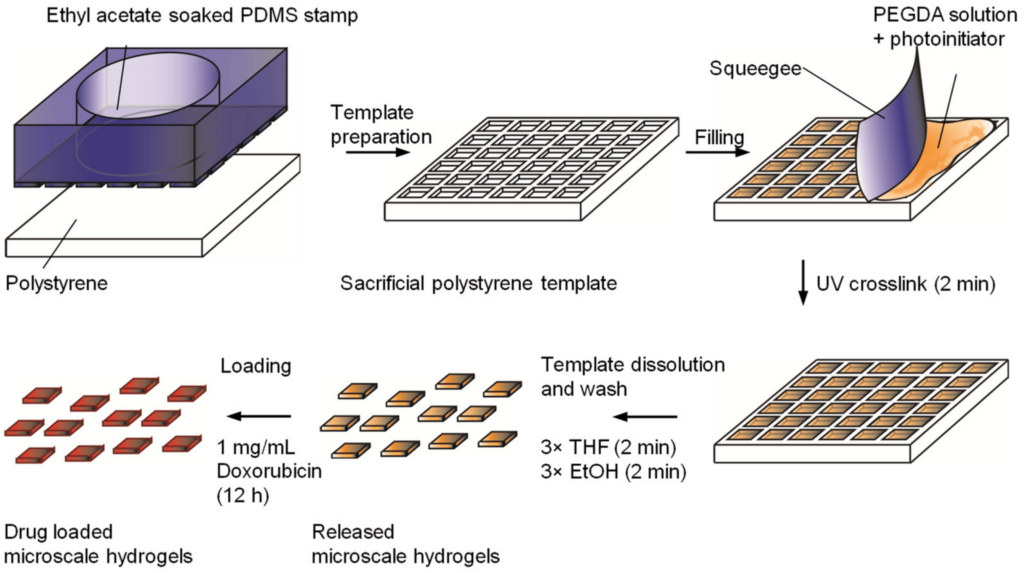
This work, started in Dresden many years back, by a fantastic undergrad student, combined new manufacturing techniques to create well-defined (all perfectly the same size) little blocks of polymers. These could be loaded with an anticancer drug, but could also be loaded with nanorods which can be heated up with near infrared light, to destroy cancer cells by heat.
56) B. Newland*, K.R. Long, Cryogel Scaffolds: Soft and Easy to use Tools for Neural Tissue Culture, Neural Regeneration Research, 2022, 17, 1981
In this short “perspective” article, we highlight the way that cryogels (soft sponge like materials) can be used to manipulate brain tissue in a dish. We highlight work that shows that cryogels can deliver reagents and drugs to specific parts of the tissue, rather than flood the whole area (which happens when they are just pipetted on top of tissue).
2021
55) M. Alghamdi, M. Gumbleton, B. Newland*, Local Delivery to Malignant Brain Tumors: Potential Biomaterial-Based Therapeutic/Adjuvant Strategies, Biomaterials Science, 2021, 9, 6037
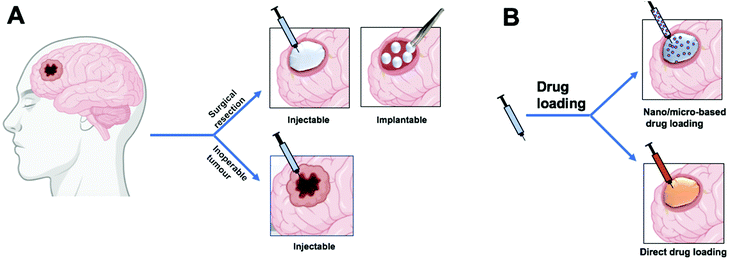
In this review, we critically appraised the literature on local delivery systems based within the following categories: polymer-based implantable devices, polymeric injectable systems, and hydrogel drug delivery systems. We also discussed the negative effect of hypoxia (lack of oxygen in the tumour) on treatment strategies and how one might utilize local implantation of oxygen-generating biomaterials as an adjuvant to enhance current therapeutic strategies.
54) S.A. Rizzo, O. Bartley, A.E. Rosser, B. Newland*, Oxygen-Glucose Deprivation in Neurons: Implications for Cell Transplantation Therapies, Progress in Neurobiology, 2021, 205, 102126
Our group is interested in Parkinson’s disease therapeutics, in particular with cell replacement therapies (designed to replace the dopamine neurons lost to the disease progression). However, the majority of neurons die soon after transplantation. In this review we consider the evidence that a simple deprivation on vital nutrition (oxygen and glucose) is a major contributor to their death. Finding a way to improve graft survival could improve the therapeutic potential of transplantation therapies – but first we need a better understanding of why they die.
53) C. Bastiancich, E. Bozzato, I. Henley, B. Newland*, Does Local Drug Delivery Still Hold Therapeutic Promise for Brain Cancer? A Systematic Review, Journal of Controlled Release, 2021, 337, 296-305
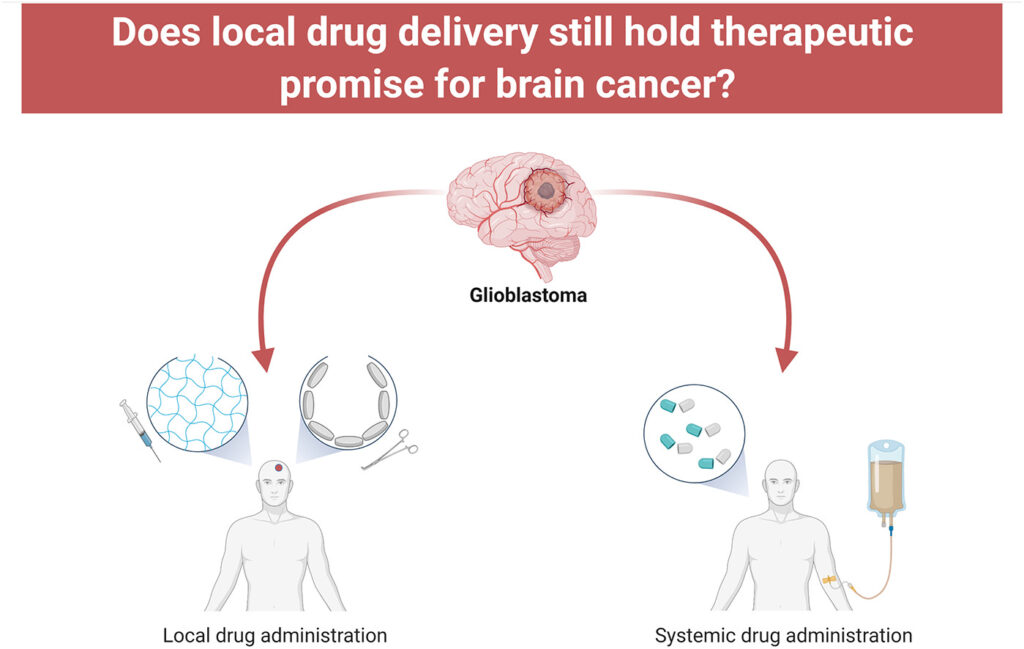
With much of the lab’s focus turning towards new therapeutic strategies for brain cancer, we conducted a review of the literature with a meta-analysis (a study of research studies) to try and see if pre-clinical (animal experiment data) shows whether local administration of drugs (i.e., directly injected or inserted into the tumour or the tumour resection cavity, showed better outcomes than the same drug administered systemically (i.e. either by mouth or injected). In sum, there is still not much data with a good direct comparison, but that which does exist indicates local delivery can outperform systemic delivery.
52) W. S. V. Ng, M. Trigano, T. Freeman, C. Varrichio, D. K. Kandaswamy, B. Newland, A. Brancale, M. Rozanowska, M. Votruba, New Avenues for Therapy in Mitochondrial Optic Neuropathies, Therapeutic Advances in Rare Disease, 2021
Optic nerve damage leading to loss of vision can be caused by a variety of insults. One group of conditions leading to optic nerve damage is caused by defects in genes that are essential for cells to make energy in small organelles called mitochondria. New treatments can potentially arise in four ways: prevention, compensation, replacement and repair of the defects. Here we explore how present and possible future treatments might provide hope for those suffering from these conditions.
51) Z. He, Q. Xu, B. Newland, R. Foley, I. Lara-Sáez, J.F. Curtin, W. Wang, Reactive Oxygen Species (ROS): Utilizing Injectable Antioxidative Hydrogels and ROS-Producing Therapies to Manage the Double-Edged Sword, Journal of Materials Chemistry B, 2021, 9, 6326,
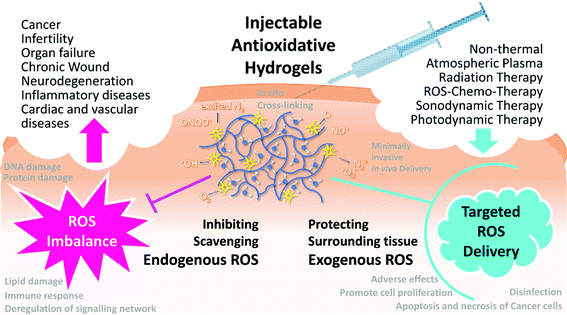
50) S. Jarrin, A. Hakami, B. Newland, E. Dowd, Growth Factor Therapy for Parkinson’s Disease: Alternative Delivery Systems, Journal of Parkinson’s Disease, 2021, 11, S229-S236
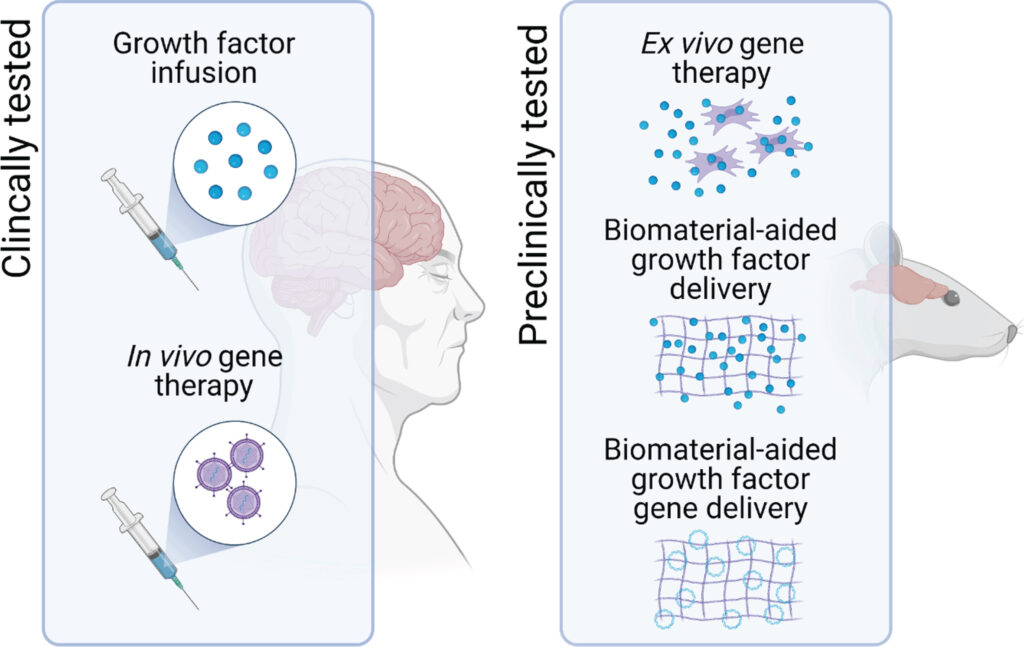
Growth factors represent a promising therapeutic approach for Parkinson’s disease as many have been shown to protect neurons. However, effective delivery to the brain remains a challenge. This short review summarizes new approaches to deliver growth factors to the brain.
49) B. Newland*, H. Newland, F. Lorenzi, D. Eigel, P. B. Welzel, D. Fischer, W. Wang, U. Freudenberg, A. Rosser, C. Werner, Injectable Glycosaminoglycan Based Cryogels from Well-Defined Microscale Templates for Local Growth Factor Delivery, ACS Chemical Neuroscience, 2021, 12, 1178–1188

This work was started prior to publication #48, and used heparin in the cryogel structure to allow it to load and release protiens via electrostatic interactions. The heparin was modified to contain maleimide groups, so that it could be photo-crosslinked together with a crosslinker (PEG diacrylate). When loaded with nerve growth factor, they caused a model neuron (PC 12 cells) to differentiate and produce neurites. In sum, these are a simple means of delivering growth factors in a controlled and sustained manner. More recent work has, however, focused on using sulfonated monomers rather than having to modify heparin, as these have the same effect but with less work/higher reproducibility. (Click here for the journal webpage).
48) D. Eigel, C. Werner, B. Newland*, Cryogel Scaffolds for Neuroscience Applications, Neurochemistry International, 2021, 147, 105012 (IF 3.881)

Dimitri reviewed the field of cryogel biomaterials that had been used for neurosciences. In a fashion typical of Dimitri’s thoroughness, what started as a “mini-review” ended as an in-depth coverage of a multitude of cryogel types for application ranging from growth factor delivery to cell delivery. With full credit to Dimitri, this would make a good point of reference to those working in the cryogel field. (Click here for the journal webpage).
47) D. Eigel, R. Schuster, M. J. Männel, J. Thiele, M. J. Panasiuk, L. C. Andreae, C. Varricchio, A. Brancale, P. B. Welzel, W. B. Huttner, C. Werner, B. Newland*, K. R. Long, Sulfonated Cryogel Scaffolds for Focal Delivery in Ex-Vivo Brain Tissue Cultures, Biomaterials, 2021, 271, 120712

This work was performed in collaboration with Dr Katie Long in King’s College London. She works with the human brain (embryonic tissue), for which there is a distinct lack of tools available for manipulating regions of tissue when they are kept in culture. She quickly saw the potential of cryogel scaffolds as an easy-to-handle tool that could be used to deliver molecules and dyes to certain brain regions. Just like hydrogels, cryogels can be extremely soft, thus not causing damage to the brain tissue when they are placed on it. However, they are also extremely robust so can be picked up with tweezers making for much easier handling than hydrogels. We also mimicked nature’s trick of using charged molecules such as heparin for the slow release of molecules, giving us precise control over the location and timing of molecule release. These cryogels are now being used for answering neuroscience questions in multiple labs now. They are versatile, easy to use and can be loaded and placed by someone without biomaterial expertise. (Click here for the journal webpage).
46) L. Zoupi, S. A. Booker, D. Eigel, C. Werner, P. C. Kind, T. L. Spires-Jones, B. Newland, A.C. Williams, Selective Vulnerability of Inhibitory Networks in Multiple Sclerosis, Acta Neuropathalogica, 2021, 141, 415-429
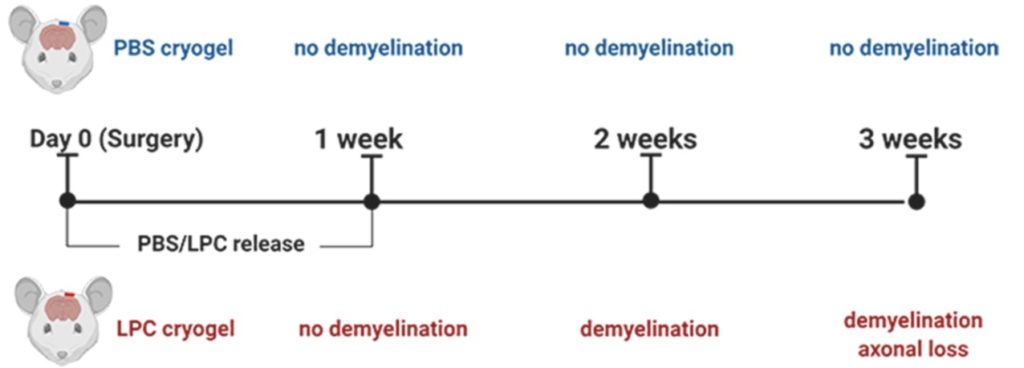
Conceptually, this work built upon the ex vivo focal demyelination method developed previously (publication #37), whereby cryogel “sponges” were used to soak up a demyelinating agent and deliver it to a specific region of the brain. However, this was performed in the live mouse brain, causing a small region of demyelinated brain tissue (Multiple Sclerosis-like pathology) surrounded by otherwise healthy brain tissue. This allowed the group of Prof. Anna Williams in Edinburgh to decipher what role demyelination plays in the death of neurons (this time in the absence of an inflammatory response) and determine that inhibitory neurons are more susceptible to damage from demyelination. (Click here for the journal webpage).
45) B. Ucar, J. Kajtez, B. M. Foidl, D. Eigel, C. Werner, K. R. Long, J. Emnéus, J. Bizeau, M. Lomora, A. Pandit, B. Newland, C. Humpel, Biomaterial Based Strategies to Reconstruct the Nigrostriatal Pathway in Organotypic Slice Co-Cultures, Acta Biomaterialia, 2021, 121, 250-262

This work was a highly collaborative effort, whereby the lab of Christian Humpel (Innsbruck) compared a range of biomaterials for delivering the growth factor GDNF (glial cell line-derived neurotrophic factor) to the nigrostriatal pathway in a slice culture model of Parkinson’s disease. Line shaped cryogels from our lab promoted neurite extension from the substantia nigra to the striatum showing potential as a repair strategy for the nigro-striatal pathway effected in Parkinson’s diease. (Click here for the journal webpage).
2020
44) M. Alghamdi, F. Chierchini, D. Eigel, C. Taplan, T. Miles, D. Pette, P. B. Welzel, C. Werner, W. Wang, C. Neto, M. Gumbleton, B. Newland*, Poly (ethylene glycol) Based Nanotubes for Tuneable Drug Delivery to Glioblastoma Multiforme, Nanoscale Advances, 2020, 2, 4498

In this work we showed that our previously developed polymer nanotubes (not carbon nanotubes) (see publication number 23 below) could be easily modified by how long they sit in sodium hydroxide. On the face of it, it is really simple, this degrades the ester bonds in the poly(ethylene glycol), leaving negatively charged carboxylic acid groups in the structure as drug loading sites. By changing the time in sodium hydroxide, we could tune the drug loading and release properties. Furthermore, we showed that, although a steady hand is required, these can be injected into 3D cultures (brain cancer spheroids) to destroy the model tumor. (Click here for the journal webpage).
43) L. Schirmer, C. Hoornaert, D. Le Blon, D. Eigel, C. Neto, M. Gumbleton, P. B. Welzel, A. E. Rosser, C. Werner, P. Ponsaerts, B. Newland*, Heparin-Based, Injectable Microcarriers for Controlled Delivery of Interleukin-13 to the Brain, Biomaterials Science, 2020, 8, 4997

In a similar manner to the paper below, we showed that heparin-based microcarriers could be used to deliver the anti-inflammatory cytokine IL-13 in a sustained manner. In collaboration with Prof. Peter Ponsaerts (Antwerp) we showed that injection of IL-13 loaded microcarriers changed the host immune response at the injection site to a more pro-regenerative phenotype. Turning the host immune response from “inflammatory” to “regenerative” could be a useful strategy for improving cell transplantation therapies in the nervous system. (Click here for the journal webpage).
42) B. Newland*, C. Varricchio, Y. Körner, F. Hoppe, C. Taplan, H. Newland, D. Eigel, G. Tornillo, D. Pette, A. Brancale, P. B. Welzel, F. P. Seib, C. Werner, Focal Drug Administration via Heparin-Containing Cryogel Microcarriers Reduces Cancer Growth and Metastasis, Carbohydrate Polymers, 2020, 254, 116504

One problem with drug delivery devices designed to deliver the drug locally to tumors is that they typically release their payload quickly without much control. To overcome this we looked to nature, specifically to heparin, a natural biopolymer to which a vast array of molecules electrostatically bind. We synthesised microscale drug carriers (called microcarriers) containing heparin, which, due to its high abundance of negative charges, could be loaded with the anticancer drug doxorubicin (contains a positive charge) and released for over a month. Injection of these drug loaded microcarriers next to breast cancer tumors reduced their growth rate and were superior to the same drug administered to the bloodstream. This study really shows the potential of charge based loading and release systems for anticancer drug delivery. (Click here for the journal webpage).
41) Y. Gao, D. Zhou, J. Lyu, S. A, Q. Xu, B. Newland, K. Matyjaszewski, H. Tai, W. Wang, Complex Polymer Architectures through Free-Radical Polymerization of Multvinyl Monomers, Nature Reviews Chemistry, 2020
In this review, we highlighted some of the contemporary experimental strategies to prepare complex polymer architectures using radical polymerization of multivinyl monomers. We also examined the recent development of characterization techniques for sub-chain connections in such complex macromolecules. Finally, we discussed how these crosslinking reactions have been engineered to generate advanced polymer materials for use in a variety of biomedical applications.
40) B. Newland*, F. Ehret, F. Hoppe, D. Eigel, D. Pette, H. Newland, P. B. Welzel, G. Kempermann, C. Werner, Macroporous Heparin-Based Microcarriers Allow Long-Term 3D Culture and Differentiation of Neural Precursor Cells, Biomaterials, 2020, 230, 119540

Neural precursor cells (NPCs) are cultured either on two-dimensional (2D) surfaces, where cells quickly reach confluency and passaging is required, or as 3D neurospheres, with the limitation of poor diffusion of nutrients and thus partial differentiation of cells over time. Herein, we culture NPCs on microscale scaffolds termed microcarriers, composed of poly(ethylene glycol) and heparin, designed to more closely represent the 3D environment of the neurogenic niche. Microcarrier culture of NPCs allows long-term cell expansion and better differentiation, which provides superior culture conditions for studying/modelling the neurogenic niche. (Click here for journal webpage).
39) B. Newland*, F. Ehret, F. Hoppe, D. Eigel, D. Pette, H. Newland, P. B. Welzel, G. Kempermann, C. Werner, Static and dynamic 3D culture of neural precursor cells on macroporous cryogel microcarriers, MethodsX, 2020, 7, 100805
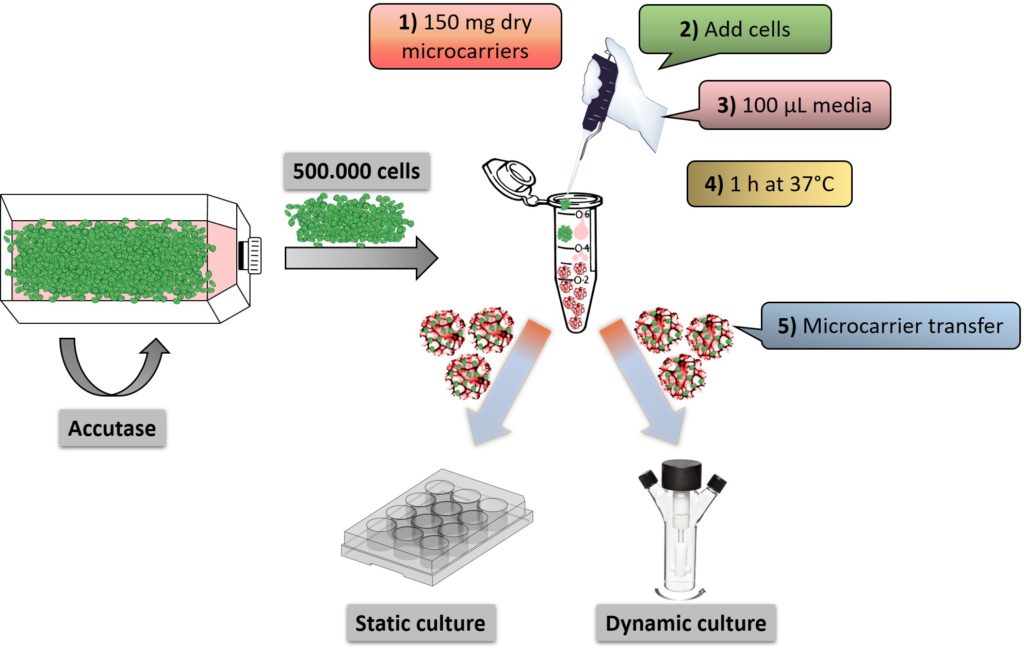
This paper describes the methods used to create microscale cryogel scaffolds (we call microcarriers) and their use for 3D culture of neural precursor cells. This methods paper is a co-submission with the Biomaterials paper above). (Click here for the journal webpage).
38) C. Varricchio, K. Beirne, C. Heard, B. Newland, M. Rozanowska, A. Brancale, M. Votruba, The Ying and Yang of Idebenone: Not Too Little, Not Too Much – Cell Death in NQO1 Deficient Cells and the Mouse Retina, Free Radical Biology and Medicine, 2020, 152, 551
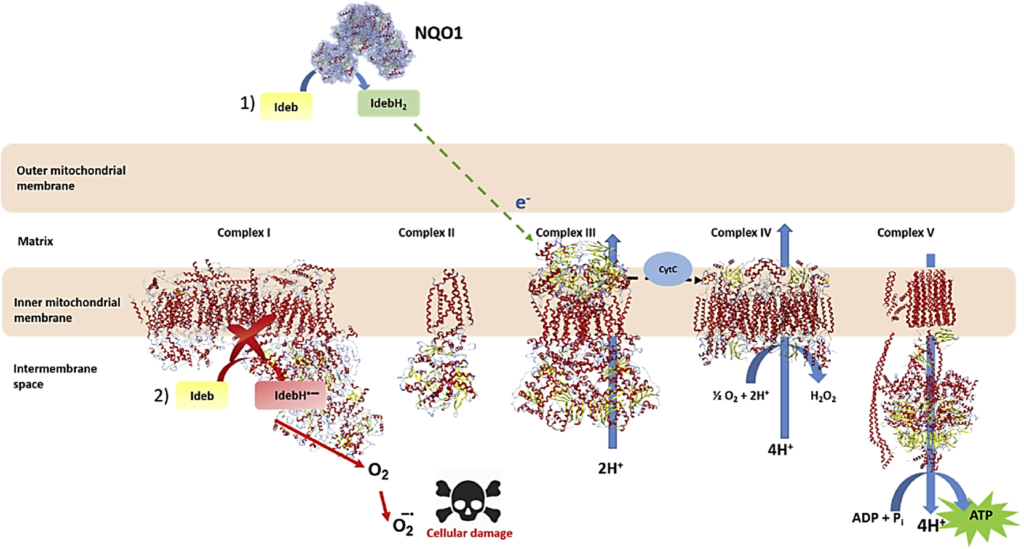
Idebenone has recently been investigated as a drug therapy for Leber’s hereditary optic neuropathy (LHON), a rare genetic mitochondrial disease that causes rapid and progressive bilateral vision loss. Although several studies have shown that idebenone can promote vision recovery in patients with LHON, the evidence for the efficacy of idebenone is still limited. In this paper we confirmed the enzyme (NQO1)-dependent activity of idebenone, but we also showed, for the first time, that the cytotoxicity of idebenone is linked to cellular expression of NQO1. Upon idebenone administration, cells deficient in NQO1 show a marked decrease in viability in comparison to NQO1 expressing cells, with idebenone causing ROS production and deleterious effects on ATP levels and cell viability. We hope that these findings will help to guide the development of future therapies and drug delivery strategies including intra-ocular administration. (Click here for journal webpage).
2019
37) D. Eigel, L. Zoupi, S. Sekizar, P. B. Welzel, C. Werner, A. Williams, B. Newland*, Cryogel Scaffolds for Regionally Constrained Delivery of Lysophosphatidylcholine to Central Nervous System Slice Cultures: A Model of Focal Demyelination for Multiple Sclerosis Research, Acta Biomaterialia, 2019, 97, 216-229
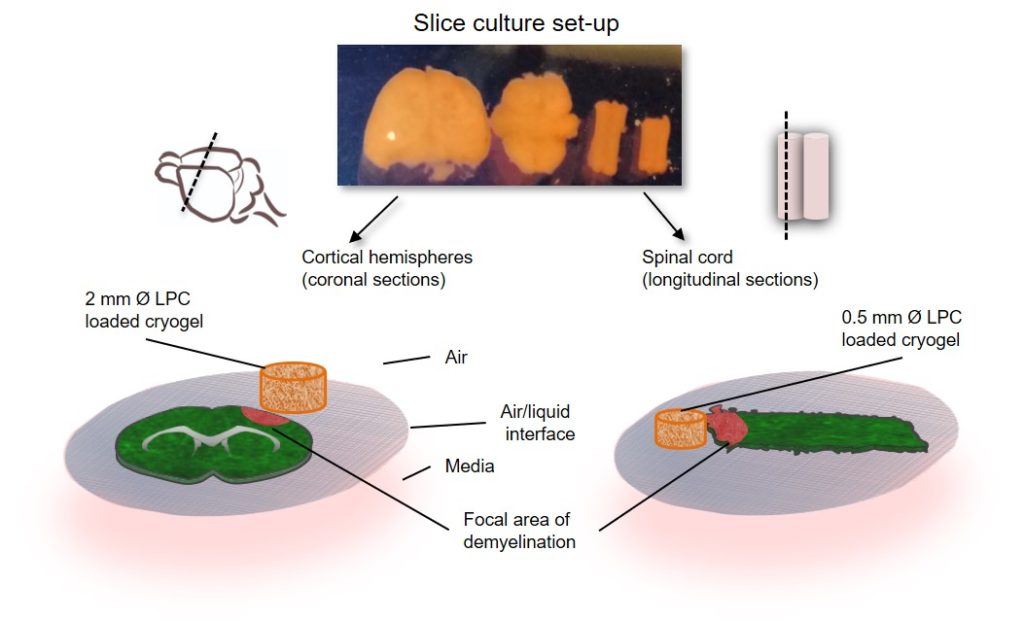
Cryogel scaffolds are robust and easy to handle making them an ideal tool for delivering reagents to tissue slice culture. Here we collaborated with Prof. Anna Williams who previously characterised a brain slice culture model of Multiple-Sclerosis (MS). In this study we used cryogels scaffolds to deliver the demyelinating agent to focal regions of the brain slice. This left regions of “healthy” tissue in proximity to demyelinated tissue – which more closely represents MS pathology in patients. Anna William’s team are now using these models to study immune reaction/remyelination of the damaged region. (Click here for journal webpage).
36) S. Liu, Y. Gao, D. Zhou, M. Zeng, F. Alshehri, B. Newland, J. Lyu, J. O’Keeffe-Ahern, U. Greiser, T. Guo, F. Zhang, W. Wang, Highly Branched Poly(β-amino-ester) Delivery of Minicircle DNA for Transfection of Cells Relevant to Neurodegenerative Diseases, Nature Communications, 2019, 10, 3307
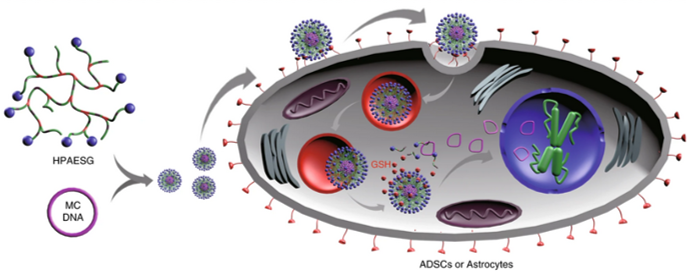
Transfection (genetic manipulation) of neurons is notoriusly difficult (see Newland et al., Nanoscale, 2014, 6, 7526 ) but transfection of astrocytes for overexpression of secreted proteins could be a valid work-around strategy. Herein we present an iterative optimisation process behind developing highly effective poly(β-amino ester)s for manipulation of astrocytes and adipose derived stem cells. (Click here for journal webpage).
2018
35) H. Newland, D. Eigel, A. E. Rosser, C. Werner, B. Newland*, Oxygen Producing Microscale Spheres Affect Cell Survival in Conditions of Oxygen-Glucose Deprivation in a Cell Specific Manner: Implications for Cell Transplantation, Biomaterials Science, 2018, 6, 2571
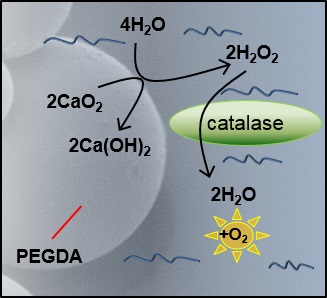
Heike produced calcium peroxide containing microspheres that produced oxygen in the presence of catalase. Although cells transplanted to the brain show signs that a lack of oxygen is causing their death, this work highlighted that glucose might we a much more critical factor for graft survival in the brain. (Click here for the journal webpage).
34) K. R. Long, B. Newland, M. Florio, N. Kalebic, B. Langen, A. Kolterer, P. Wimberger, W. B. Huttner, Extracellular Matrix Components HAPLN1, Lumican, and Collagen I Cause Hyaluronic Acid-Dependent Folding of the Developing Human Neocortex, Neuron, 2018, 99, 702
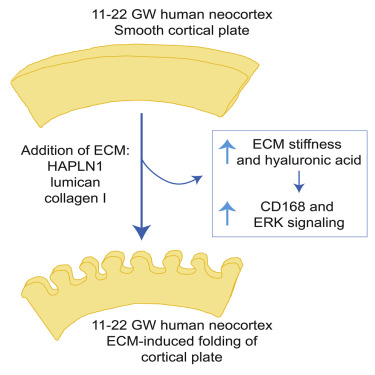
Would you like to learn more about how our brains fold in utero? Katie’s magnificent work describes how extracellular matrix components effect brain folding in normal development and disease. (Click here for the journal webpage). To find out more about Dr. Katie Long and her work, click here to visit her webpage.
33) B. Newland*, C. Taplan, D. Pette, J. Friedrichs, M. Steinhart, W. Wang, B. Voit, F.P. Seib, C. Werner, Soft and Flexible Poly (ethylene glycol) Nanotubes for Local Drug Delivery, Nanoscale, 2018, 10, 8413

Here we synthesised soft polymer nanotubes. Their flexibility seems to be why they are not toxic (i.e. they don’t have the asbestos-like properties of some carbon nanotubes). We loaded them with the anticancer drug doxorubicin (a mainstay treatment for breast cancer) and our collaborator (Dr. Philipp Seib) showed that direct injection of the drug-loaded nanotubes next to the breast cancer tumor was more effective than intravenous administration of the drug. I.e. local delivery is more effective than systemic delivery. This exciting discovery was picked up by various media outlets including “theengineer.co.uk“. (Click here for the journal webpage).
32) H. Zhang, T. Zhao, B. Newland, W. Liu, W. Wang, W. Wang, Catechol Functionalized Hyperbranched Polymers as Biomedical Materials, Progress in Polymer Science, 2018, 78, 47
A review of how polymers that contain catechol groups can be synthesised and used as biomedical materials. Catechol groups are present in the “adhesive” that marine mussels use for anchorage. Their ability to adhere in wet conditions makes them a very interesting topic of research for tissue adhesives that must function well in the presence of body fluids. (Click here for the journal webpage).
2017
31) B. Newland*, M. Baeger, D. Eigel, H. Newland, C. Werner, Oxygen-Producing Gellan Gum Hydrogels for Dual Delivery of Either Oxygen or Peroxide with Doxorubicin, ACS Biomaterials Science & Engineering 2017, 3, 787

We have been very interested in how best to make oxygen producing materials. Herein we tried using a naturally occurring polysaccharide called Gellan Gum to encapsulate an anticancer drug and produce oxygen, in an attempt to improve the therapeutic efficacy of the drug. (Click here for the journal webpage).
30) Y. Gao, B. Newland, D. Zhou, K. Matyjaszewski, W. Wang, Controlled Polymerization of Multivinyl Monomers: Formation of Cyclized/Knotted Single Chain Polymer Architectures, Angewandte Chemie International Edition, 2017, 56, 450
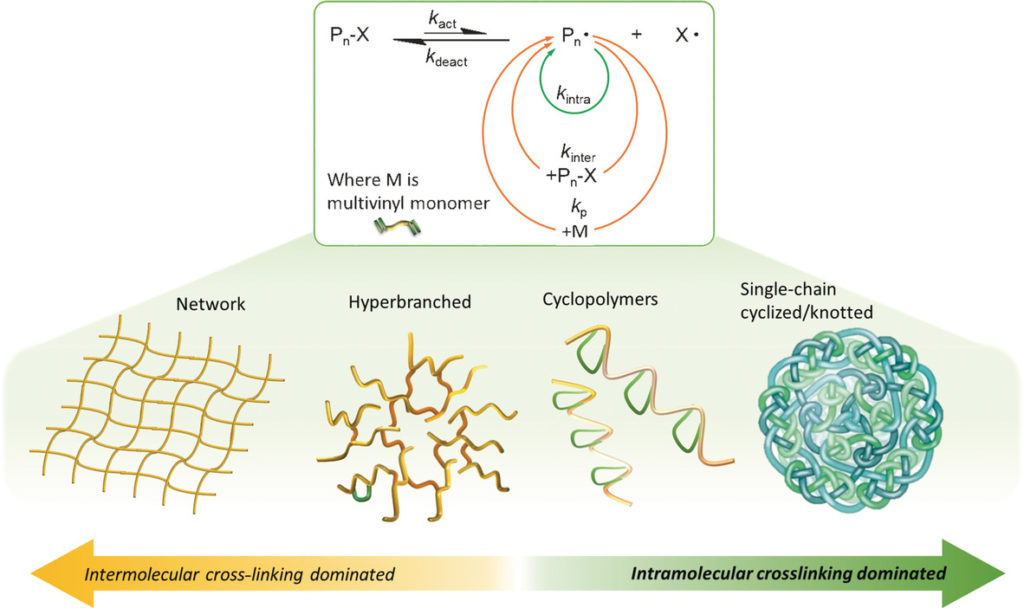
– This paper is also available in German “Kontrollierte Polymerisation von Multivinyl‐Monomeren: Bildung einer cyclischen/verknoteten Einzelketten‐Polymerarchitektur” – A big “Thank You” to Dr. Marcus Binner for the translation! (Click here for journal webpage).
2016
29) M. Abu-Rub‡, B. Newland‡, M. Naughton, W. Wang, S. McMahon, A. Pandit, (‡ these authors contributed equally), Non-viral xylosyltransferase-1 siRNA delivery as an effective alternative to chondroitinase in an in vitro model of reactive astrocytes, Neuroscience, 2016, 339, 267

Mohammad’s PhD work on the inhibitory effect that chondroitin sulfate proteoglycans (CSPGs) has on neurite outgrowth lead us to investigate whether siRNA silencing of xylotransferase-1 would make a more permissive environment for axon recovery (for example after spinal cord injury). (Click here for the journal webpage).
28) B. Newland, S. B. Dunnett, E. Dowd, Targeting Delivery in Parkinson’s Disease, Drug Discovery Today, 2016, 21, 1313

A review paper written with Eilis Dowd and Stephen Dunnett highlighting the different means of delivering therapeutics to the Parkinsonian brain. (Click here for the journal webpage).
27) D. Zhou, Y. Gao, A. Aied, L. Cutlar, O. Igoucheva, B. Newland, V. Alexeeve, U. Greiser, J. Uitto, W. Wang, Highly Branched Poly(β-amino ester)s for Skin Gene Therapy, Journal of Controlled Release, 2016, 244, 336
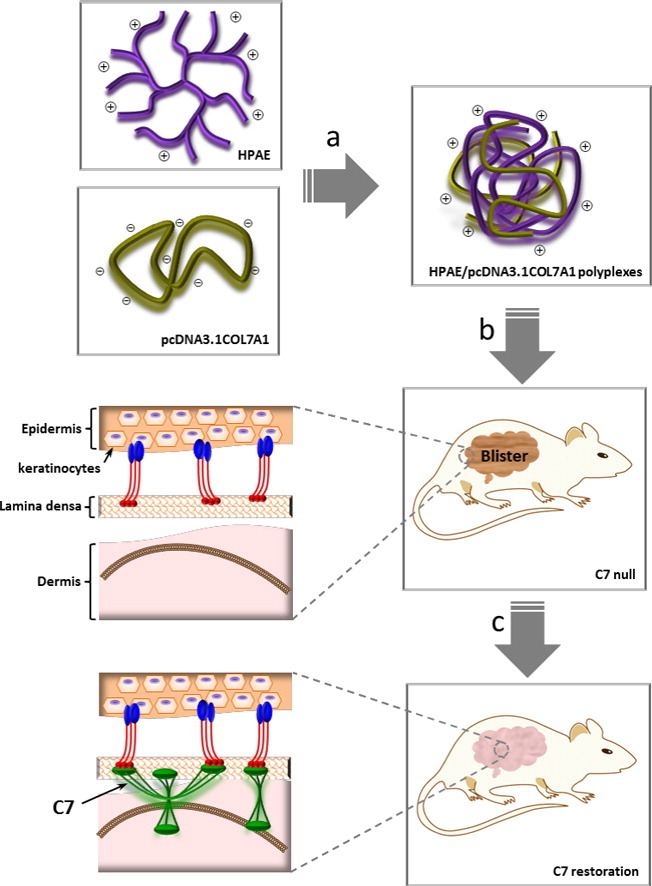
This work showed how a biodegradable type of polymer called poly(beta-amino esters) can be used to deliver DNA encoding collagen 7 to replace deficient collagen in skin diseases. (Click here for the journal webpage).
26) B.Newland*, L. Thomas, Y. Zheng, M. Steinhart, C. Werner, W. Wang, Preparation, Loading, and Cytotoxicity Analysis of Polymer Nanotubes from an Ethylene Glycol Dimethacrylate Homopolymer in Comparison to Multi‐Walled Carbon Nanotubes, Journal of Interdisciplinary Nanomedicine, 2016, 1, 9

In a similar manner to our Scientific Reports paper on polymer nanotubes, herein we used another cyclized knot polymer synthesized by Dr. Yu Zheng to form beautiful polymer nanotubes. The template synthesis mechanism was also refined and dye loading was analysed (Click here for the journal webpage).
25) B. Newland*, P. Wolff, D. Zhou, W. Wang, H. Zhang, A. Rosser, W. Wang, C. Werner*, Synthesis of ROS Scavenging Microspheres from a Dopamine Containing Poly (β-Amino Ester) for Applications for Neurodegenerative Disorders, Biomaterials Science, 2016, 4, 400

This paper consists of some of the work that Paul Wolff carried out during his very successful Master’s thesis (top grade received). These dopamine containing microspheres not only scavenged free radicals, but also reduced the dissolved oxygen content of cell culture media. (Click here for the journal webpage).
24) L. Breydo, B. Newland, H. Zhang, A. Rosser, C. Werner, V. N. Uversky, W. Wang, A Hyperbranched Dopamine-Containing PEG-Based Polymer for the Inhibition of α-Synuclein Fibrillation, Biochemical and Biophysical Research Communications, 2016, 469, 830

This work, carried out in collaboration with Dr. Leo Breydo at the University of Florida, shows how dopamine inhibits the fibrillation of the Parkinson’s associated protein α-synuclein. Vicky (Hong Zhang) synthesised a dopamine containing polymer by RAFT polymerization which could also inhibit α-synuclein fibrillation, but to a lesser extent than dopamine. (Click here for the journal webpage).
2015
23) B. Newland*, D. Leupelt, Y. Zheng, L. S.V. Thomas, C. Werner, M. Steinhart, W. Wang. Magnetically Controllable Polymer Nanotubes from a Cyclized Crosslinker for Site-Specific Delivery of Doxorubicin, Scientific Reports, 2015, 5, 17478
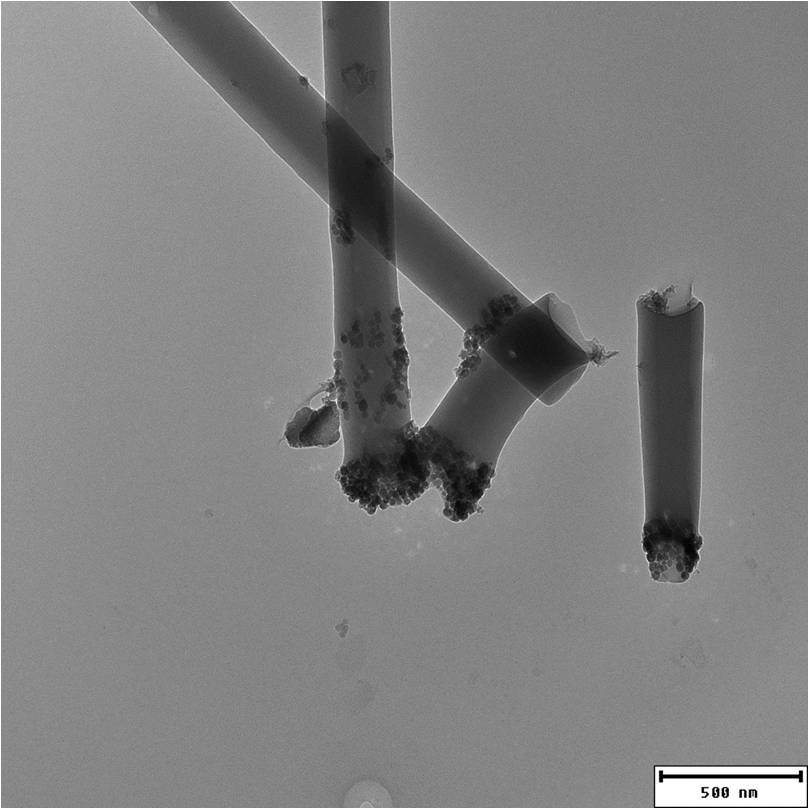
How long would you expect nanotubes of such high surface area to volume ratio to release a drug for? A few minutes… an hour, or even a day? These nanotubes release doxorubicin over a period of a week. They can be functionalized with iron oxide nanoparticles to make them magnetically controllable. These early findings have spurred us to investigate these interesting, low toxic and easy to make nanotubes, so more to come! (Click here for the journal webpage).
22) B. Newland*, P. B. Welzel, H. Newland, C. Renneberg, P. Kolar, M. Tsurkan, A. Rosser, U. Freudenberg, C. Werner*, Tackling Cell Transplantation Anoikis: An Injectable, Shape Memory Cryogel Microcarrier Platform Material for Stem Cell and Neuronal Cell Growth, Small, 2015, 11, 5047

This paper describes the synthesis of microcarriers that have a highly macroporous structure that can collapse during injection and reform once out of the needle. The main drive of this work is to try and create a cell transplantation platform to improve the survival of cells after transplantation to the brain. (Click here for the journal webpage).
21) H. Zhang, T. Zhao, B. Newland, P. Duffy, A. Ní Annaidh, E. D. O’Cearbhaill, W. Wang, On-Demand and Negative-Thermo-Swelling Tissue Adhesive Based on Highly Branched Ambivalent PEG–Catechol Copolymers, Journal of Materials Chemistry B, 2015, 3, 6420

The last work together with Hong Zhang and Tianyu Zhao before their move to Seattle. (Click here for the journal webpage).
20) B. Newland*, H. Newland, C. Werner, A. Rosser, W. Wang*, Prospects for Polymer Therapeutics in Parkinson’s Disease and Other Neurodegenerative Disorders, Progress in Polymer Science, 2015, 44, 79
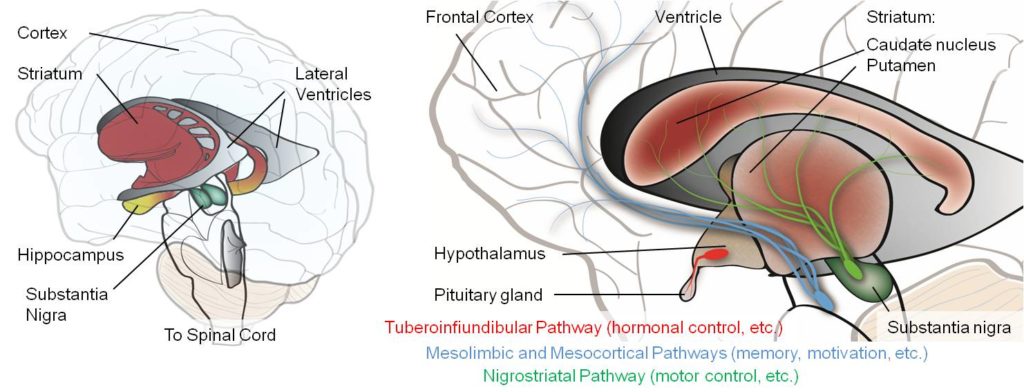
Look at the authors names! We are now married! Our first work together, and the first publication since the start of my fellowship, where we cover several aspects of using polymers and biomaterials in the rodent brain for a variety of tissue engineering applications. (Click here for the journal webpage).
2014
19) A. Aied, Y. Zheng, B. Newland, W. Wang. Beyond Branching: Multiknot Structured Polymer for Gene Delivery. Biomacromolecules , 2014, 15, 4520

With the high degree of control over the polymerization process that in situ deactivation enhanced ATRP allows, one can continue the polymer growth beyond the single cyclized knot stage (publications #4, 7 and 18 below) until the knots combine. The disulfide links between the knots give rise to biodegradability whereby the multi-knot structure can break down into smaller knots, for lower cytotoxicity. (Click here for the journal webpage).
18) B. Newland, A. Aied, A. V. Pinoncely, Y. Zheng, T. Zhao, H. Zhang, R. Niemeier, E. Dowd, A. Pandit, W. Wang, Untying a Nanoscale Knotted Polymer Structure to Linear Chains for Efficient Gene Delivery In Vitro and to the Brain, Nanoscale, 2014, 6, 7526
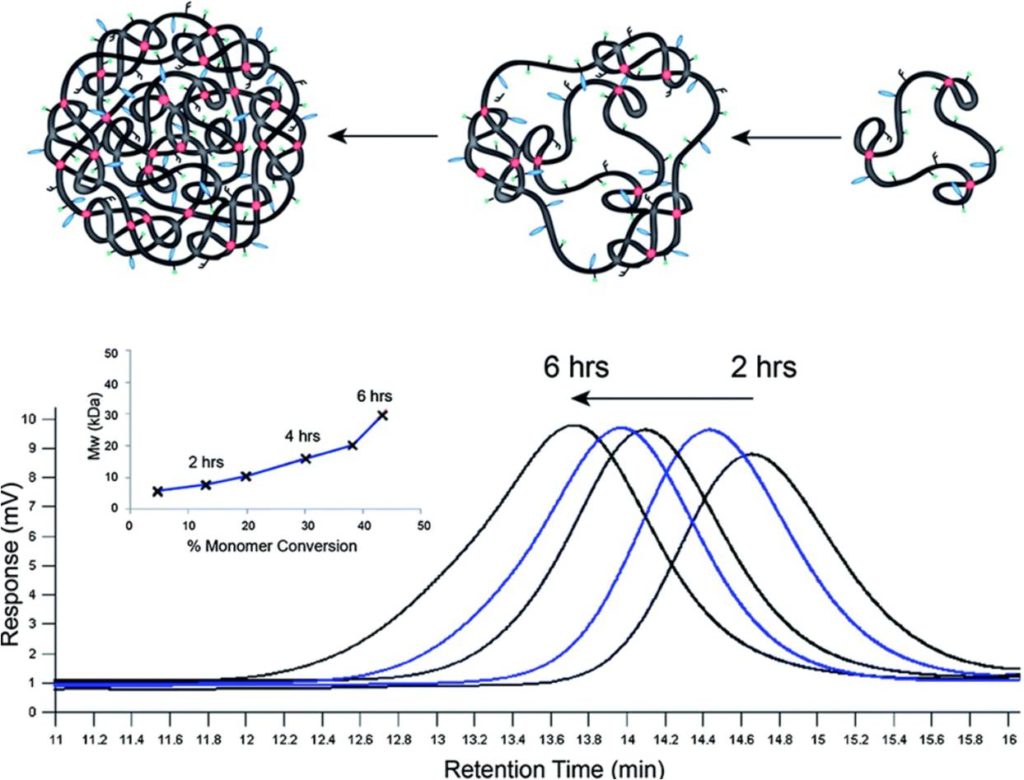
This was the final work from my PhD thesis, whereby I used a disulfide monomer incorporated into the knot structured polymer developed in the work in publication #7 below. Degradation of this disulfide link did not cause the polymer to degrade, but rather “untie” since the covalently bound polymer backbone was not effected. This is a great example of how a polymer that can work well in vitro may perform poorly in vivo. This has prompted us (a collaboration between myself and my then PhD co-supervisor, turned collaborator – Wenxin Wang) to pursue a new direction of research with poly(beta-amino esters), for a high in vivo performance. (Click here for the journal webpage).
17) T. Zhao, H. Zhang, B. Newland, A. Aied, D. Zhou, W. Wang, Significance of Branching for Transfection: Synthesis of Highly Branched Degradable Functional Poly(dimethylaminoethyl methacrylate) from Vinyl Oligomer Combination, Angewandte Chemie, 2014, 53, 6095
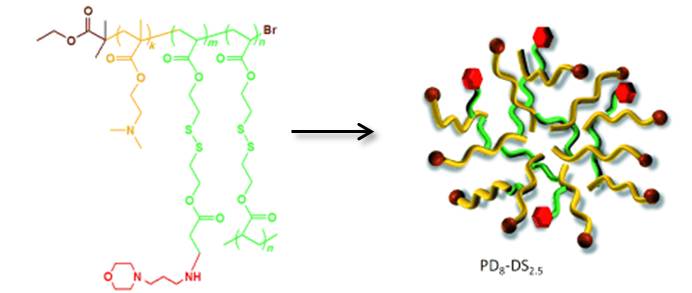
In this work Tianyu took full advantage of the vinyl oligomer assembly approach developed in his previous Nature Communications article to create highly branched polymers for gene transfection. The higher the degree of branching (nearly 10% for the most branched polymer tested!), the higher the transfection capability. The inclusion of the disulfide branching unit resulted in minimal cytotoxicity as the polymer can be reduced to smaller units. (Click here for the journal webpage).
16) H. Zhang, L. P. Bré, T. Zhao, B. Newland, M. Da Costa, W. Wang, Biomimetic Hyperbranched Poly(amino ester)-based Nanocomposite as Tunable Bone Adhesive for Sternal Closure, Journal of Materials Chemistry B, 2014, 2, 4067
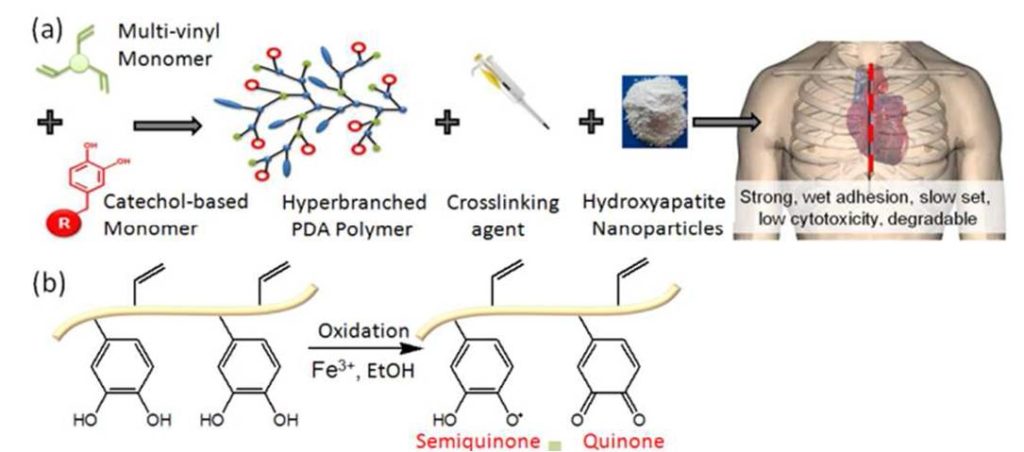
With some tweaking and the addition of hydroxyapatite nanoparticles, the polymer based on dopamine (described in publication 15 below) was tested for its ability to adhere sternal bone. Currently wires are used to stitch the sternum back together after open chest surgery. The lack of rigidity means the healing time is typically around three months. When an adhesive is used (such as Kryptonite (now withdrawn)) this can be vastly reduced, but comes at the price of added complications if emergency re-entry into the chest is required soon after surgery (for example, unexpected internal bleeding etc). Instead, this dopamine based polymer sets slowly, but cures strongly and adheres well to bone even in wet conditions. (Click here for the journal webpage).
2013
15) H. Zhang, L. P. Bré, T. Zhao, Y. Zheng, B. Newland*, W. Wang*. Mussel-Inspired Hyperbranched Poly(amino ester) Polymer as Strong Wet Tissue Adhesive, Biomaterials, 2013, 35, 711
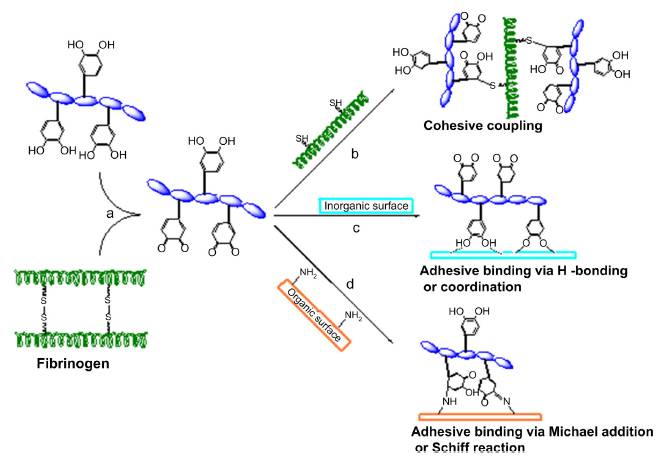
A polymer composed of dopamine shows promise as a tissue adhesive because a variety of crosslinkers can be used, such as fibrinogen, allowing controllable curing rate, low exotherm, low toxicity and the ability to adhere in wet conditions. (Click here for the journal webpage).
14) D. B. Hoban‡, B Newland‡, T. Moloney, L. Howard, A. Pandit, E. Dowd (‡ these authors contributed equally to the work). The Reduction in Immunogenicity of Neurotrophin Overexpressing Stem Cells After Intra-striatal Transplantation by Encapsulation in an In Situ Gelling Collagen Hydrogel, Biomaterials, 2013, 34, 9420
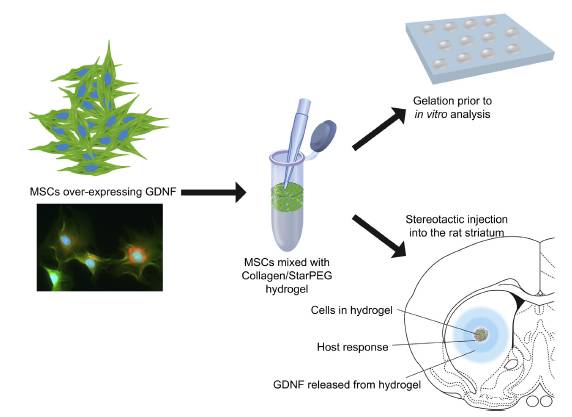
This was work performed with my then co-supervisor Dr. Eilís Dowd and her group to investigate whether the use of a collagen hydrogel could increase the survival of mesenchymal stem cells after transplantation to the brain. The stem cells were genetically modified to over produce glial cell line-derived neurotrophic factor, a protein which holds promise for protecting dopaminergic neurons (those lost during Parkinson’s disease). Although no improvement in survival was shown, a reduction in the density of the host response was observed surrounding the transplant. I think that materials to assist transplantation could provide much benefit if cells are pre-adhered to the material prior to transplantation. This work featured as part of a review (Advances in hydrogel delivery systems for tissue regeneration). (Click here for journal webpage).
13) Y. Zheng, T. Zhao, B. Newland, J. Poly, W. Wang. Controlled Homopolymerization of Multi-vinyl Monomers: From ATRA to Dendritic Polymers, Chemical Communications, 2013, 49, 10124
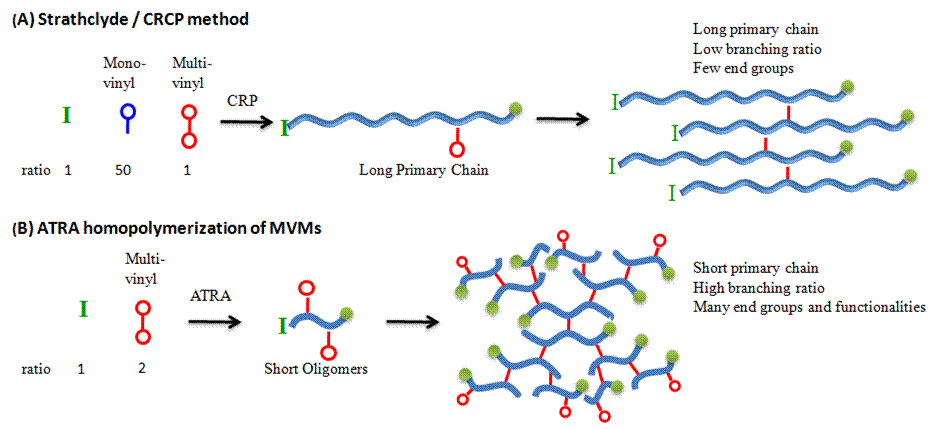
This work shows that conventional ATRP gives rise to poor monoadducts or small oligomer formation. Thus long primary chains are formed. To increase the branching ratio, we sought an optimal monoadduct, thus the combination of these small chains would give a far more branched structure. Atom transfer radical addition (ATRA), when tweeked to use a large proportion of Copper I catalyst (as with the Deactivation Enhanced ATRP in my previous publications), allows good small oligomer formation (small chains) and thus a hyperbranched polymer with a high branching ratio of 28% was achieved. (Click here for the journal webpage).
12) L. Yao, W. Daly, B. Newland, S. Yao, W. Wang, B. K. K. Chen, N. Madigan, A. Windebank, A. Pandit. Improved axonal regeneration of transected spinal cord mediated by multichannel collagen conduits functionalized with neurotrophin-3 gene, Gene Therapy, 2013, 20, 1149
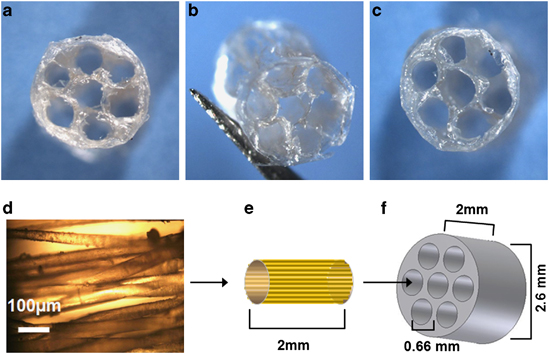
In vivo analysis of non-viral gene delivery to the spinal cord via a collagen scaffold. Dr. Li Yao used the cyclized knot polymer to deliver the neurotrophin-3 gene to promote axonal regeneration. (Click here for the journal webpage).
11) B. Newland, E. Dowd, A. Pandit. Biomaterial Approaches to Gene Therapies for Neurodegenerative Disorders of the CNS, Biomaterials Science, 2013, 1, 556
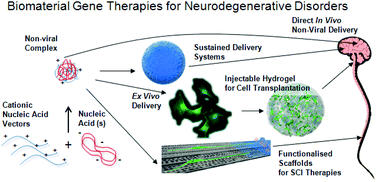
My first review paper covering every (I’m pretty sure!) non-viral transfection study in the brain. These are categorized into four tables, liposomal, polymeric, other and targeted transfection agents. In addition, ex-vivo approaches are mentioned, with particular note on using biomaterials to increase cell survival post transplantation, currently a big problem. (Click here for journal webpage).
10) B. Newland‡, M. Abu-Rub‡, M. Naughton, Y. Zheng, A. Pinoncely, E. Collin, E. Dowd, W. Wang, A. Pandit (‡ these authors contributed equally to the work). GDNF Gene Delivery Via A 2-(Dimethylamino)ethyl Methacrylate Based Cyclized Knot Polymer For Neuronal Cell Applications, ACS Chemical Neuroscience, 2013, 4, 540
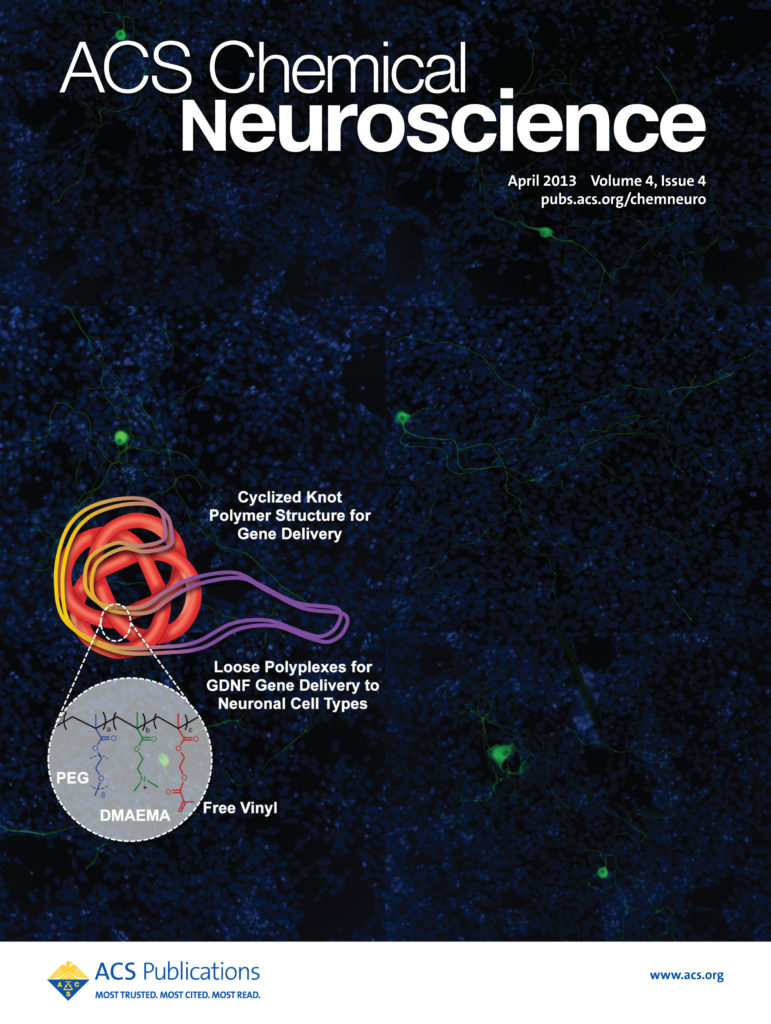
This was work was carried out jointly with Mohammad Abu-Rub where we used the polymer developed in publication 7 to transfect Neu7 astrocytes (developed in Prof. J. Fawcett’s lab). They form a neuroinhibitory environment, so after seeding dorsal root ganglia on top of pre-seeded astrocytes we measured the neurite lengths with and without the addition of the growth factor GDNF gene therapy. Treatment with the GDNF encoding gene via the cyclized polymer resulted in extended neurite outgrowth, similar to that of a high dose of GDNF recombinant protein. (Click here for journal webpage). See also the cover art for that issue (April 2013).
9) B. Newland, T. Moloney, S. Browne, G. Fontana, M. Abu-Rub, E. Dowd, A. Pandit, The Neurotoxicity Of Gene Vectors And Its Amelioration By Packaging With Collagen Hollow Spheres, Biomaterials, 2013, 34, 2130
The toxicity of non viral gene vectors towards the brain (striatum) was compared with an adeno-associated virus. The non-viral vectors caused smaller areas of gross tissue loss than the viral vector, and could be ameliorated further by use of collagen spheres developed in Prof. Abhay Pandits lab. Transfection was not measured in this study but some of our previous experiments show that the commercially available non-viral vectors are so far behind viral transfection in the striatal region of the brain. (Click here for the journal webpage).
2012
8) D. Velasco, G. Réthoré, B. Newland, J. Parra, C. Elvira, A. Pandit, L. Rojo, J. San Román, Low polydispersity (N-ethyl Pyrrolidine Methacrylamide-co-1-vinylimidazole) Linear Oligomers For Gene Therapy Applications, European Journal of Pharmaceutics and Biopharmaceutics, 2012, 82, 465
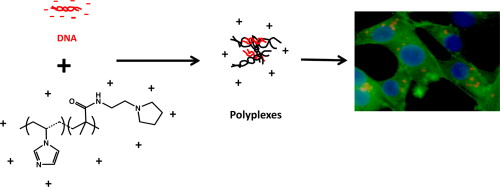
This was work in collaboration with Dr. Diego Velasco who was then a visiting PhD student in our lab from the Institute of Polymer Science & Technology, Madrid, Spain. His self synthesized EPA monomer was combined with 1-vinylimidazole to produce a linear transfection agent with low toxicity and good haemocompatibility. (Click here for journal webpage).
7) B. Newland‡, Y. Zheng‡, J. Yao, H. Cao, M. Abu-Rub, W. Wang and A. Pandit (‡ these authors contributed equally to the work). Single Cyclized Molecule Versus Single Branched Molecule: A Simple And Efficient 3D “Knot” Polymer Structure For Nonviral Gene Delivery, Journal of the American Chemical Society, 2012, 134, 4782
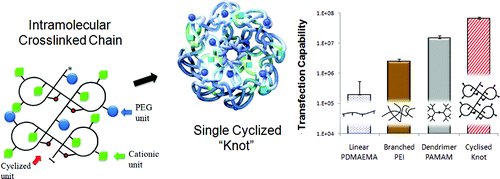
This originally started out to be a full study, continuing from my first publication (see Chem Comm below), where I would optimise the polymer for gene delivery and analyse it over a range of cell types. However, subsequent elucidation by Drs. Yu Zheng and Wenxin Wang of the polymer structures we were forming made it clear that internal cyclization was occuring. Furthermore, in an attempt to gain higher molecular weights more suitable for gene delivery, I radically increased the monomer to initiator ratio from 50:1 to 1000:1 not really realising that I had just used the optimal conditions for internal cyclization. Single chains were formed which wrapped to themselves and created a highly effective polymer for gene transfection. With PEG added into the structure in the “one pot” reaction, these polymers also showed low toxicity. They were compared to SuperFect® so as to compare two 3D structures. (Click here for journal webpage).
6) Y. Zheng, B. Newland, H. Tai, A. Pandit, W. Wang. Single Cyclized Molecule Structures From RAFT Homopolymerization Of Multi-Vinyl Monomers, Chemical Communications, 2012, 48, 3085

The deactivation enhanced nature of Dr. Wenxin Wang’s ATRP stems from the deactivating CuII catalyst remaining in the reaction vessel. However, interestingly RAFT has a natural deactivating species in the form of the RAFT agent. It thus makes RAFT an attractive tool for polymerisation with multi-vinyl monomers. A student asked me why no homopolymerisation of EGDMA had been done by RAFT before. It can be done, easily… (Click here for journal webpage).
5) A. O. Saeed‡,B. Newland‡, A. Pandit and W. Wang (‡ these authors contributed equally to the work). The Reverse Of Polymer Degradation: In Situ Crosslinked Gel Formation Through Disulfide Cleavage, Chemical Communications, 2012, 48, 585
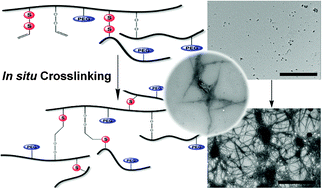
An interesting observation when Dr. Aram Saeed was synthesizing degradable PEG based polymers using a disulphide branching agent. We found that due to the large amount of free vinyl groups left in the structure, when the disulphide bond was cleaved in glutathione (to create -SH) these thiols reacted with the free vinyl groups and crosslinked the polymer into nanogels. Could be interesting to investigate further. (Click here for journal webpage).
2011
4) Y. Zheng, H. Cao, B. Newland, Y. Dong, A. Pandit and W. Wang. 3D Single Cyclized Polymer Chain Structure From Controlled Polymerization of Multi-Vinyl Monomers: Beyond Flory-Stockmayer Theory, Journal of the American Chemical Society, 2011, 133, 13130

Here’s where the real leap in our understanding is demonstrated. As noted in the description of my first publication (see Chem Comm below), our experiments with the di-vinyl monomer EGDMA at 10% of monomer feed showed a low polydispersity index, much more typical to that of a linear polymer chain, not a hyperbranched polymer. Instead, here we use 100% EGDMA (homopolymerisation), and by Deactivation Enhanced ATRP developed by Dr. Wenxin Wang, we show that actually single polymer chains are produced that link to themselves via intramolecular crosslinks (i.e. within the same chain). Being based in Ireland we initially termed these Celtic Knots as an easy way to envisage the continually looping structure (see blog/Irish Times press article). When the branching monomer EGDMA was swapped for a degradable monomer, the knot could indeed be “untied” into linear chains. (Click here for journal webpage).
2010
3) C. Holladay, M. Keeney, B. Newland, A. Mathew, W. Wang and A. Pandit. A Reliable Method for Detecting Complexed DNA In Vitro, Nanoscale, 2010, 2, 2718
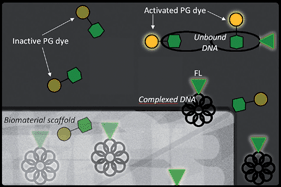
Work in collaboration with my colleagues showing that detecting DNA via Cy5 labeling resulted in more accurate detection when complexed to cationic polymers or liposomes. The PicoGreen® dye would not fluoresce when DNA was bound to SuperFect® or PEI, but would with LipoFectin™ and our lab synthesized polymers (from publication one). (Click here for journal webpage).
2) Y. Dong, P. Gunning, H. Cao, A. Mathew, B. Newland, A. O. Saeed, J. P. Magnusson, C Alexander, H Tai, A. Pandit and W. Wang. Dual Stimuli Responsive PEG Based Dendritic Polymers, Polymer Chemistry, 2010, 1, 827
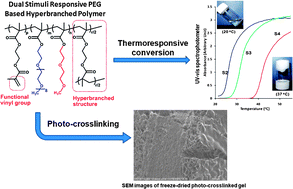
Work by Yixiao Dong showing that by adjusting the PEG chain length thermoresponsive polymers that gel upon nearing body temperature can be synthesised. Furthermore, due to the presence of free vinyl groups, these can be crosslinked by UV light. (Click here for journal webpage).
1) B. Newland, H. Tai, Y. Zheng, D. Velasco, A. Di Luca, S. M. Howdle, C. Alexander , W. Wang and A. Pandit, A Highly Effective Gene Delivery Vector – Hyperbranched Poly(2-(Dimethylamino) Ethyl Methacrylate) From In-situ Deactivation Enhanced ATRP, Chemical Communications, 2010, 46, 4698
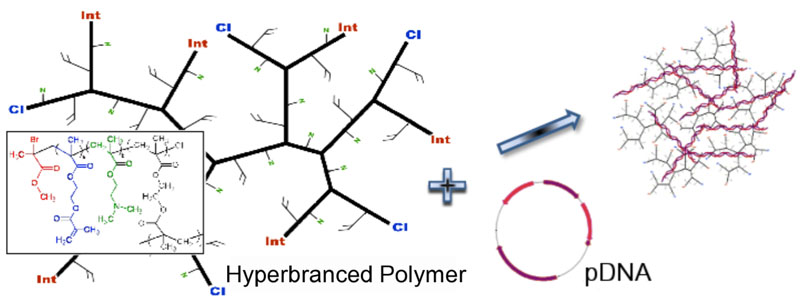
My first publication, showing how the simple synthesis mechanism, developed by my then co-supervisor Dr. Wenxin Wang, could be used to create polymers with a high amount (10%) of of the branching monomer EGDMA. Often, when over 1% of a branching monomer is used in a co-polymer system, it is difficult to stop gelation occurring. A “hyperbranced” polymer was produced that used DMAEMA to wrap up DNA into nanoparticles to deliver it to fibroblast cells. I say “hyperbranched” in inverted commas because with such a low polydispersity index (<1.5 for most of the synthesis) clearly something other than simple chain combination was occurring (see publication 4 and 7). (Click here for journal webpage).
